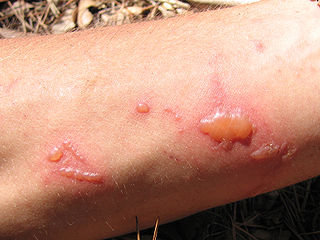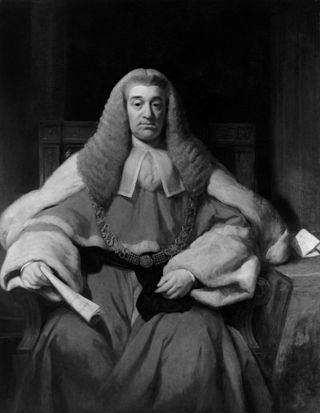
The American Psychological Association (APA) is the largest scientific and professional organization of psychologists in the United States, with over 146,000 members, including scientists, educators, clinicians, consultants, and students. It has 54 divisions—interest groups for different subspecialties of psychology or topical areas. The APA has an annual budget of around $125 million.

A placebo can be roughly defined as a sham medical treatment. Common placebos include inert tablets, inert injections, sham surgery, and other procedures.
In law, provocation is when a person is considered to have committed a criminal act partly because of a preceding set of events that might cause a reasonable individual to lose self control. This makes them less morally culpable than if the act was premeditated (pre-planned) and done out of pure malice. It "affects the quality of the actor's state of mind as an indicator of moral blameworthiness."
An assay is an investigative (analytic) procedure in laboratory medicine, mining, pharmacology, environmental biology and molecular biology for qualitatively assessing or quantitatively measuring the presence, amount, or functional activity of a target entity. The measured entity is often called the analyte, the measurand, or the target of the assay. The analyte can be a drug, biochemical substance, chemical element or compound, or cell in an organism or organic sample. An assay usually aims to measure an analyte's intensive property and express it in the relevant measurement unit.
Provocation, provoke or provoked may refer to:
Psychodynamic psychotherapy and psychoanalytic psychotherapy are two categories of psychological therapies. Their main purpose is revealing the unconscious content of a client's psyche in an effort to alleviate psychic tension, which is inner conflict within the mind that was created in a situation of extreme stress or emotional hardship, often in the state of distress. The terms "psychoanalytic psychotherapy" and "psychodynamic psychotherapy" are often used interchangeably, but a distinction can be made in practice: though psychodynamic psychotherapy largely relies on psychoanalytical theory, it employs substantially shorter treatment periods than traditional psychoanalytical therapies. Psychodynamic psychotherapy is evidence-based; the effectiveness of psychoanalysis and its relationship to facts is disputed.

Phototoxicity, also called photoirritation, is a chemically induced skin irritation, requiring light, that does not involve the immune system. It is a type of photosensitivity.

Sir Nicolas Conyngham Tindal, PC was a celebrated English lawyer who successfully defended the then Queen of the United Kingdom, Caroline of Brunswick, at her trial for adultery in 1820. As Chief Justice of Common Pleas, an office he held with distinction from 1829 to 1846, he was responsible for the inception of the special verdict "Not Guilty by reason of insanity" at the trial of Daniel M'Naghten.
In English law, provocation was a mitigatory defence to murder which had taken many guises over generations many of which had been strongly disapproved and modified. In closing decades, in widely upheld form, it amounted to proving a reasonable total loss of control as a response to another's objectively provocative conduct sufficient to convert what would otherwise have been murder into manslaughter. It only applied to murder. It was abolished on 4 October 2010 by section 56(1) of the Coroners and Justice Act 2009, but thereby replaced by the superseding—and more precisely worded—loss of control defence.
An anxiogenic or panicogenic substance is one that causes anxiety. This effect is in contrast to anxiolytic agents, which inhibits anxiety. Together these categories of psychoactive compounds may be referred to as anxiotropic compounds.

Skin allergy testing comprises a range of methods for medical diagnosis of allergies that attempts to provoke a small, controlled, allergic response.
Minretumomab (CC49) is a mouse monoclonal antibody that was designed for the treatment of cancers that express the TAG-72 antigen. This includes breast, colon, lung, and pancreatic cancers. Apparently, it never got past Phase I clinical trials for this purpose.
Kiranjit Ahluwalia is an Indian woman who fatally burned her husband in 1989 in the UK. She claimed it was in response to ten years of physical, psychological, and sexual abuse. After initially being convicted of murder and sentenced to life in prison, Ahluwalia's conviction was later overturned on grounds of inadequate counsel and replaced with voluntary manslaughter. Although her submission of provocation failed, she successfully pleaded the partial defence of diminished responsibility under s.2 Homicide Act 1957 on the grounds that fresh medical evidence may indicate diminished mental responsibility.

The Diagnostic and Statistical Manual of Mental Disorders, Fifth Edition (DSM-5), is the 2013 update to the Diagnostic and Statistical Manual of Mental Disorders, the taxonomic and diagnostic tool published by the American Psychiatric Association (APA). In 2022, a revised version (DSM-5-TR) was published. In the United States, the DSM serves as the principal authority for psychiatric diagnoses. Treatment recommendations, as well as payment by health care providers, are often determined by DSM classifications, so the appearance of a new version has practical importance. However, not all providers rely on the DSM-5 for planning treatment as the ICD's mental disorder diagnoses are used around the world and scientific studies often measure changes in symptom scale scores rather than changes in DSM-5 criteria to determine the real-world effects of mental health interventions. The DSM-5 is the only DSM to use an Arabic numeral instead of a Roman numeral in its title, as well as the only living document version of a DSM.
An elimination diet, also known as exclusion diet, is a diagnostic procedure used to identify foods that an individual cannot consume without adverse effects. Adverse effects may be due to food allergy, food intolerance, other physiological mechanisms, or a combination of these. Elimination diets typically involve entirely removing a suspected food from the diet for a period of time from two weeks to two months, and waiting to determine whether symptoms resolve during that time period. In rare cases, a health professional may wish to use an elimination diet, also referred to as an oligoantigenic diet, to relieve a patient of symptoms they are experiencing.
A glossary of terms used in clinical research.
People v. Berry is a voluntary manslaughter case that is widely taught in American law schools for the appellate court's unusual interpretation of heat of passion doctrine. Although the defendant had time to "cool down" between his wife's verbal admission of infidelity and the killing, the California Supreme Court held that the provocation in this case was adequate to reduce a murder charge to manslaughter. The lower court had relied on the traditional definition of "adequate provocation" in its jury instructions. The California Supreme Court reversed Berry's murder conviction, while affirming Berry's conviction for assault using deadly force.
DPP v Camplin (1978) was an English criminal law appeal to the House of Lords in 1978. Its unanimous judgment helped to define the main limits of defence of provocation chiefly until Parliament replaced the defence with one of "loss of control" in the Coroners and Justice Act 2009. Its ratio decidendi continues to have precedent value as the new "loss of control" defence is a renaming to avoid creep of the term into scenarios for which it was never intended, above all a blurring with diminished responsibility.
People v. Valentine, 28 Cal.2d 121, 169 P.2d 1 (1946) is a landmark California Supreme Court voluntary manslaughter case where the court holds that mere words may be adequate provocation.
The Taylor Aggression Paradigm is a prominent, well-validated, laboratory analog measure of aggressive behavior in humans, predominantly utilized within the field of psychology.





